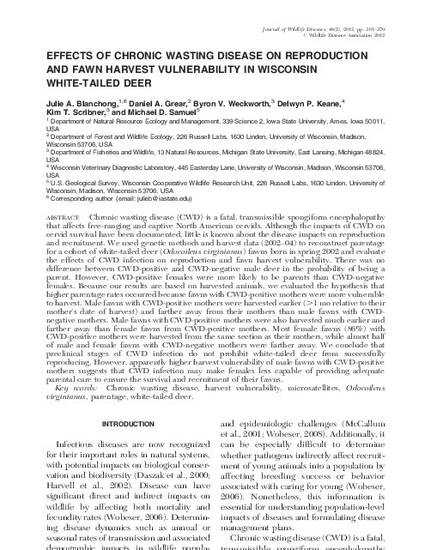
Chronic wasting disease (CWD) is a fatal, transmissible spongiform encephalopathy that affects free-ranging and captive North American cervids. Although the impacts of CWD on cervid survival have been documented, little is known about the disease impacts on reproduction and recruitment. We used genetic methods and harvest data (2002–04) to reconstruct parentage for a cohort of white-tailed deer (Odocoileus virginianus) fawns born in spring 2002 and evaluate the effects of CWD infection on reproduction and fawn harvest vulnerability. There was no difference between CWD-positive and CWD-negative male deer in the probability of being a parent. However, CWD-positive females were more likely to be parents than CWD-negative females. Because our results are based on harvested animals, we evaluated the hypothesis that higher parentage rates occurred because fawns with CWD-positive mothers were more vulnerable to harvest. Male fawns with CWD-positive mothers were harvested earlier (.1 mo relative to their mother’s date of harvest) and farther away from their mothers than male fawns with CWDnegative mothers. Male fawns with CWD-positive mothers were also harvested much earlier and farther away than female fawns from CWD-positive mothers. Most female fawns (86%) with CWD-positive mothers were harvested from the same section as their mothers, while almost half of male and female fawns with CWD-negative mothers were farther away. We conclude that preclinical stages of CWD infection do not prohibit white-tailed deer from successfully reproducing. However, apparently higher harvest vulnerability of male fawns with CWD-positive mothers suggests that CWD infection may make females less capable of providing adequate parental care to ensure the survival and recruitment of their fawns.
Available at: http://works.bepress.com/julie_blanchong/6/

This article is from Journal of Wildlife Diseases 48 (2012): 361, doi:10.7589/0090-3558-48.2.361.